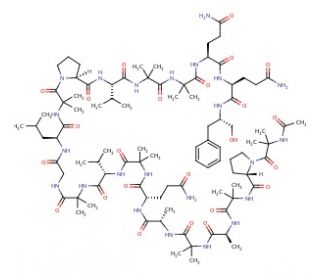

Alamethicin F50 (CAS 56165-93-6)
QUICK LINKS
Alamethicin F50, identified by the CAS number 56165-93-6, is a peptide antibiotic that is part of a broader class of compounds known as peptaibols, which are typically produced by fungi from the genus Trichoderma. Alamethicin F50 is particularly notable for its role in forming voltage-dependent ion channels in phospholipid bilayers. This mechanism involves the insertion of the alamethicin molecule into a lipid membrane, facilitated by its amphipathic nature—it possesses both hydrophobic and hydrophilic regions. Upon insertion, alamethicin aggregates to form a helical bundle that spans the lipid bilayer, creating a pore that disrupts cellular ion gradients. This disruption allows for the uncontrolled flow of ions, particularly calcium and sodium, across the cell membrane, which can lead to increased membrane permeability and ultimately, cellular dysfunction. In research, alamethicin F50 has been extensively used to study membrane biophysics, including the dynamics of peptide-lipid interactions and the functional modeling of ion channel behavior. These studies are crucial for understanding the fundamental properties of cellular membranes and ion channel operation, offering insights into the basic principles of electrophysiology and potential applications in developing synthetic ion channels and new methods for controlling bioelectrical processes in cells.
Alamethicin F50 (CAS 56165-93-6) References
- The ion-channel activity of longibrachins LGA I and LGB II: effects of pro-2/Ala and gln-18/Glu substitutions on the alamethicin voltage-gated membrane channels. | Cosette, P., et al. 1999. Biochim Biophys Acta. 1461: 113-22. PMID: 10556493
- Template-free self-assembling fullerene and lipopeptide conjugates of alamethicin form voltage-dependent ion channels of remarkable stability and activity. | Jung, G., et al. 2003. J Pept Sci. 9: 784-98. PMID: 14658798
- Studies on the selective trifluoroacetolytic scission of native peptaibols and model peptides using HPLC and ESI-CID-MS. | Theis, C., et al. 2008. Chem Biodivers. 5: 2337-55. PMID: 19035563
- Biosynthesis of Fluorinated Peptaibols Using a Site-Directed Building Block Incorporation Approach. | Rivera-Chávez, J., et al. 2017. J Nat Prod. 80: 1883-1892. PMID: 28594169
- Prealamethicin F50 and related peptaibols from Trichoderma arundinaceum: Validation of their authenticity via in situ chemical analysis. | Rivera-Chávez, J., et al. 2017. RSC Adv. 7: 45733-45751. PMID: 29379602
- Melittin and a chemically modified trichotoxin form alamethicin-type multi-state pores. | Hanke, W., et al. 1983. Biochim Biophys Acta. 727: 108-14. PMID: 6824646
- Effects of polycations on ion channels formed by neutral and negatively charged alamethicins. | Rink, T., et al. 1994. Eur Biophys J. 23: 155-65. PMID: 7525266
- Proline at position 14 of alamethicin is essential for hemolytic activity, catecholamine secretion from chromaffin cells and enhanced metabolic activity in endothelial cells. | Dathe, M., et al. 1998. Biochim Biophys Acta. 1370: 175-83. PMID: 9518597
- Membrane permeabilisation and antimycoplasmic activity of the 18-residue peptaibols, trichorzins PA. | Béven, L., et al. 1998. Biochim Biophys Acta. 1372: 78-90. PMID: 9651487
Ordering Information
| Product Name | Catalog # | UNIT | Price | Qty | FAVORITES | |
Alamethicin F50, 2.5 mg | sc-391715 | 2.5 mg | $255.00 |
